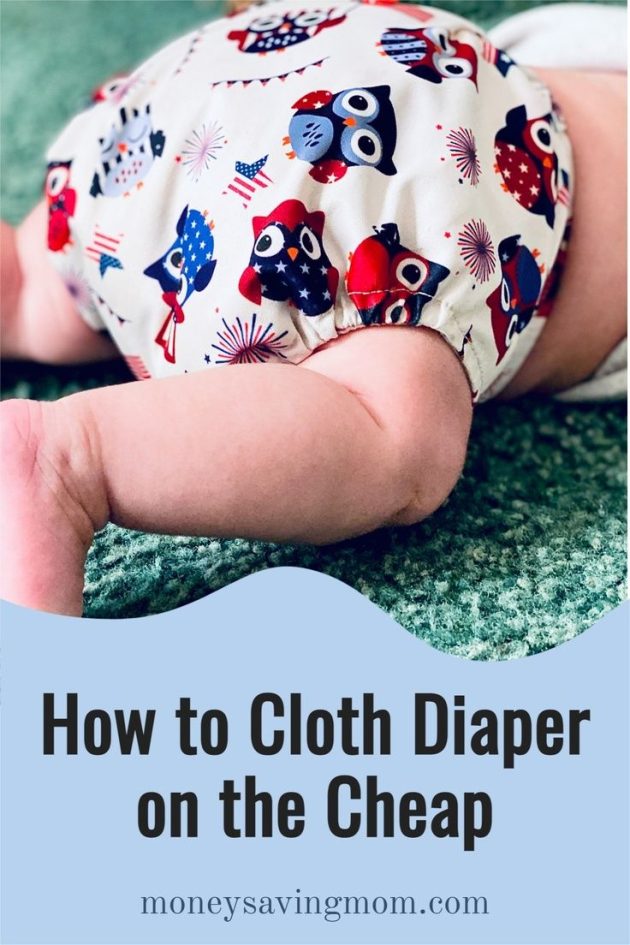Interested in Cloth Diapering and wondering how to best utilize it to save you money? Read these great tips!
The following is a guest post by Bailey Bouwman of Cloth Diaper Podcast:
Why spend nearly $40 on a cloth diaper, when you can buy them on Amazon for less than $10? This is a good question and it’s a hard one to justify or even reason with as a cloth diaper podcaster.
A lot of the time the difference between a $5 cloth diaper and a $30 cloth diaper is a few extra parts and a marketing team. There might be a few other things in between, but it’s typically just more tummy panels, snaps, and higher-quality textiles.
Luckily, you don’t need all those gizmos to successfully cloth diaper your babies. You just need a can-do attitude and the support of a few great cloth diapering parents.
…so, buy the cheap cloth diapers. 
How to Cloth Diaper on the Cheap
Here are a few more tips to help you cloth diaper on the cheap!
1. Don’t buy too cheap of a diaper.
You don’t need the top of the line, but I’d also advise you to stay away from the cheapest of the cloth diapers that have minimal snaps and PUL you can see through. You want something that has a classic Alva Baby or Happy Flute Design.
2. Skip synthetic inserts.
Most parents ditch synthetic inserts after 18 months because of wear & tear, increased bladders, and poor performance.
Here are 3 options to create better more natural inserts for less money (and they actually work better!):
- Minimal Cost – Repurpose cotton towels, t-shirts, or receiving blankets into padded inserts. Not only are they easy to wash and dry, but they are also more absorbent than most inserts.
- Low Cost – Opt for a size 2 (infant size not newborn size) cotton pre-fold for an insert (usually works out to about 25-50 cents per ounce of absorbency). These pre-folds offer a standard absorbency that can handle many situations. Look for a product that is about the size of a piece of paper (give or take). You don’t want too long because it won’t fit.
- Mid/High Cost – Bamboo or hemp blend inserts can be another great alternative. They can be a more expensive product giving you $1-2/ounce. Most families need to use an insert and booster, or two inserts, for daytime absorbency. One insert is okay for a light-wetter or low-flow child.
3. Start small and buy more later.
Because every child is different and every cloth diaper brand is too, it’s often beneficial to start with a small stash and buy more later if you like a certain brand.
I usually recommend buying two different brands so that you have a backup in case the other just doesn’t work for you.
4. Only buy what you need.
It’s easy to get caught up in all the prints and latest styles, but this will kill your pocketbook. The best way to stay true to your cloth diapering budget is to close the amazon tab and walk away from the computer.
Many families start with just 10 cloth diapers and wash nightly, while others build up a stash of closer to 50-60, so they can wash on the weekends and send diapers to daycare. Whether you need a small or large stash, buy what you need and walk away.
Cheap cloth diapers can work for you!
Looking for more cloth diapering resources? Try these:
- Why Cloth Diapering Doesn’t Have to Be Hard
- Cloth Diapering 101
- Use Cloth Diapers to Save at Least $100 Per Year
- Swagbucks Paid for Our Cloth Diapers
Bailey Bouwman is the host of the Cloth Diaper Podcast, a regular show dedicated to sharing the stories behind cloth diaper parents and brands. As an author of Cloth Diapers, The Ultimate Guide to Textiles, Washing and More, Bailey is passionate to finding simple solutions to cloth diapers. Bailey lives with her husband and their two children in Prince George, BC.
Do you have any other cloth diapering tips? We’d love to hear!



